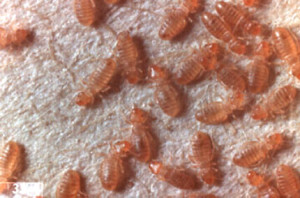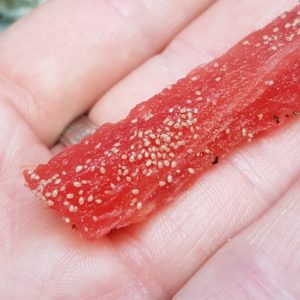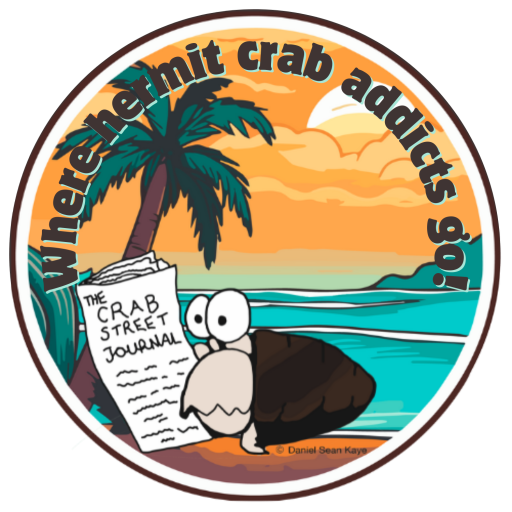Originally written by Vanessa Pike-Russell-Updated by Stacy Griffith

Common Name/Scientific Name
- Dust Mites-House Dust Mite Dermatophagoides sp.
- Grain Mites Acarus siro L
- House Mouse Mite-Liponyssoides sanuineus (Hirst)
- Follicle Mite-Demodex folliculorum (Simon)
- Itch or Scabies Mite-Sarcoptes scabiei hominis (Hering)
Mold Mite-Tyrophagus putrescentiae (Schrank)
Dust Mites – House Dust Mite Dermatophagoides sp.
“Dust mites are microscopic, small enough to live inside the weave and fibers of your clothing, bedding carpet and such. They don’t actually bite they are waaay to small .. they actually live on the skins flakes we shed. When people have problems with dust mites it is because they are actually allergic to the proteins in their saliva and excrement! So there is precious little on a hermit crab to attract or sustain a dust mite.
Grain Mites – Grain Mite Acarus siro L.
“Stored grain is subject to insect infestation and deterioration from molds and bacteria. High grain temperatures and moisture, along with dockage and broken kernels, provide conditions that accelerate mold and insect development. Many grain insects are good fliers and move to newly stored grain from fields and from infested grain bins. Insects can reach a high population size in unchecked grain bins, in sub floors or aeration ducts in bins, in equipment used to move grain, or in discarded refuse grain. These areas must be kept free of insects to reduce migration to newly harvested grain.
Grain insects move within the grain mass at a rate that is determined by the and grain temperature. During the summer and fall, insect infestations are usually on the surface of the grain. In cold weather, insects congregate at the center and lower portions of the grain and may escape detection until high population numbers are reached.” (Vera Krischik, USDA FGIS and the Institute of Ecosystem Studies Wendell Burkholder, USDA ARS and the University of Wisconsin)
Grain Mite Infestation: Prevention and Control
This site has information about the Grain Mite, which feeds on food similar to that which we offer our hermit crabs i.e., Wheat Germ , Soyabean Meal, Rolled Oats, etc.
“Mite populations can explode when they feed on wheat germ, yeast, cheese, powdered milk, flour, or grain. In finely ground commodities such as flour and powdered milk, infestations are confined to the surface layer. Whole or cracked grains and nuts may be infested throughout.” (Linda J. Mason and John Obermeyer, Department of Entomology

Grain and Mold Mites
These mites can be found in a wide variety of stored products and food and can cause mild dermatitis known as “grocer’s itch.” Heavy infestations have a sweet or minty odor. A coating of “mite dust,” molted skins of the mites, covers the infested grain or cheese. Sometimes the surface of infested materials appears to move due to large numbers of mites. These mites favor damp areas. They do not bite humans. (William F. Lyon W. Calvin Welbourn
Common Mite Species
Index of Mites for Identification
A list or index to many types of mites that are attracted to grain and will infest areas where foods like wheat germ, soybean meal, rice meal, flour, oats and cereals exist.
Are the mites/bugs in your tank harmful?
Not all bugs are harmful to your hermit crabs and many are beneficial. Check out our guide to bugs in the crabitat before you panic. Drop some of the mites into a container of water to make them easier to photograph for identification.
Treatment for Mites
A crabarium that is infested with mites and other pests cause hermit crabs to become stressed, lose limbs and die. It is important that you do not use chemicals that could be harmful to hermit crabs in ridding their home and yours of pests.
Hermit crabs are very sensitive to the presence of chemicals and they may suffocate if pesticides are sprayed close by. Keep the tank covered and wherever possible, find a natural alternative in cleaning products.
If you DO have mites, this is one way that I have found to get rid of them:
The substrate and crabarium items boiled and dried, your tank cleaned out with vinegar paying special attention to the silicone inside, and give your hermit crabs a dechlorinated ocean/sea water bath until they are free of these pests. The mites should float to the surface during the baths. As Jenn notes, mites are often attracted to wood and plants so make sure you rid the crabarium of wood that attracts mites and other bugs until the crabitat is pest free.
You may need to use a magnifying glass to zoom in, make sure you have rid your tank of these pests, and keep a screen lid on your tank under your glass/Plexiglas lid to keep the flies, mites and bugs away from your crabs and their food. Always remove fresh fruits the morning after to keep your hermit crabs safe from infestation.
Biological solution to mites
Let predatory mites get rid of your parasitic mites and fungus gnats. Read about Hypoaspis Mites
Stratiolaelaps scimitus (formerly Hypoaspis miles) is a soil-dwelling mite capable of the prevention, control, and management of sciarid flies, shore flies and various thrips and soil pests. Not only are these mites predators of thrips’ prepupal and pupal stages, they are very effective fungus gnat predators as well.
Mites – General information https://wiki.bugwood.org/Invertebrates2#Mites
Soil Mites:
References:
William F. Lyon, W. Calvin Welbourn. Mites Annoying Humans
HYG-2101-95. URL : http://ohioline.osu.edu/hyg-fact/2000/2101.html
Linda J. Mason and John Obermeyer, Department of Entomology.
URL: http://www.agcom.purdue.edu/AgCom/Pubs/GQ/GQ-13.html
Vera Krischik, USDA FGIS and the Institute of Ecosystem Studies
Wendell Burkholder, USDA ARS and the University of Wisconsin
URL: http://ipmworld.umn.edu/chapters/krischik/index.html
Insect Publications Oklahoma Cooperative Extension Service
Home and Garden Insects
URL: http://agweb.okstate.edu/pearl/insects/home/
https://www.insectary.com/portfolio-items/control-fungus-gnats-stratio-s/

